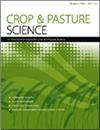澳大利亚东南部随机调查确定的野生燕麦(Avena spp.)、雀麦草(Bromus spp.)和大麦草(Hordeum spp.)的抗除草剂频率
IF 1.9
4区 农林科学
Q2 AGRICULTURE, MULTIDISCIPLINARY
引用次数: 0
摘要
本文章由计算机程序翻译,如有差异,请以英文原文为准。
Frequency of herbicide resistance in wild oats (Avena spp.), brome grass (Bromus spp.) and barley grass (Hordeum spp.) as determined by random surveys across south-eastern Australia
ABSTRACT Context. Wild oats (Avena spp.), brome grass (Bromus spp.) and barley grass (Hordeum spp.) are significant grass weeds of crop production in south-eastern Australia. The presence of herbicide resistance in these weed species is a major limiting factor on both productivity and profitability. Aims. We aimed to determine the distribution of herbicide resistance in these weed species across south-eastern Australia. Methods. Several surveys were conducted in randomly selected fields across four states in south-eastern Australia over a 5-year period, collecting 663 wild oats, 366 brome grass and 262 barley grass samples that were screened for resistance with up to five different herbicide groups or subgroups. Key results. In wild oats, resistance was most common to clodinafop-propargyl (‘fop’ ACCase inhibitor), with 22% of samples resistant and resistance detected in all regions except Tasmania. Resistance to sulfonylurea herbicides (ALS inhibitors) was less common with 7% of samples resistant, but regionally more variable. For both brome grass and barley grass, a greater proportion of samples was resistant to the sulfonylurea mesosulfuron-methyl, at 24% and 19%, respectively, than to quizalofop-ethyl (‘fop’ ACCase inhibitor). Conclusions. Resistance was recorded in all three species, with differences in the extent of resistance among herbicide groups and regions. Overall, a higher than average frequency of wild oats resistance to clodinafop-propargyl was found in regions of New South Wales and of brome grass and barley grass resistance to mesosulfuron-methyl in regions of South Australia. However, for all species some herbicides were still effective on all samples. Implications. The presence of significant herbicide resistance in these weed species indicates that management decisions need to include consideration of resistance to enable successful control measures.
求助全文
通过发布文献求助,成功后即可免费获取论文全文。
去求助
来源期刊

Crop & Pasture Science
AGRICULTURE, MULTIDISCIPLINARY-
CiteScore
4.20
自引率
15.80%
发文量
111
审稿时长
3 months
期刊介绍:
Crop and Pasture Science (formerly known as Australian Journal of Agricultural Research) is an international journal publishing outcomes of strategic research in crop and pasture sciences and the sustainability of farming systems. The primary focus is broad-scale cereals, grain legumes, oilseeds and pastures. Articles are encouraged that advance understanding in plant-based agricultural systems through the use of well-defined and original aims designed to test a hypothesis, innovative and rigorous experimental design, and strong interpretation. The journal embraces experimental approaches from molecular level to whole systems, and the research must present novel findings and progress the science of agriculture.
Crop and Pasture Science is read by agricultural scientists and plant biologists, industry, administrators, policy-makers, and others with an interest in the challenges and opportunities facing world agricultural production.
Crop and Pasture Science is published with the endorsement of the Commonwealth Scientific and Industrial Research Organisation (CSIRO) and the Australian Academy of Science.
 求助内容:
求助内容: 应助结果提醒方式:
应助结果提醒方式:


